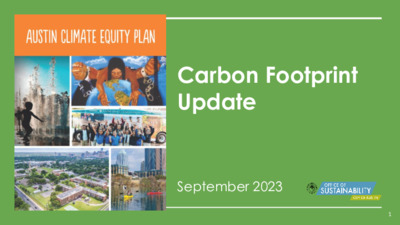1. City of Austin Carbon Footprints Update — original pdf
Backup

Carbon Footprint Update September 2023 1 Austin’s Carbon Emissions 2 Carbon Accounting Protocols International leader on climate science For communities, like the Austin area For organizations like COA, CapMetro 3 Carbon Emission “Scopes” “BURN” “BUY” “BEYOND” Fuels you burn directly Transportation fuel Water and space heating fuel Electricity District Energy Indirect offsite emissions Everything else Production and delivery of goods and services Can occur anywhere in the world Hard to measure Traditional Carbon Footprint 4 Carbon Footprint Boundaries City of Austin Daily Operations Austin Extra-territorial Jurisdiction Municipal Carbon Footprint Community-wide Carbon Footprint 5 Austin’s Carbon Emissions 6 City of Austin Municipal Footprint Boundary Sources Electricity Natural Gas District Energy City Vehicles Refrigerants Carbon Offsets City of Austin Daily Operations GreenChoice Energy since 2012 Space and water heating City Hall, Central Library, Austin Convention Center Fleet, emergency aircraft, mileage reimbursements Estimate based on fleet and facility purchase orders Local tree plantings, Airport and Convention Center 7 City of Austin Municipal Footprint CITY OF AUSTIN Municipal Carbon Footprint Net emissions in 2022 44K Metric Tons CO₂e Electricity Natural Gas District Energy City Vehicles Refrigerants Offsets Link: COA Municipal Carbon Footprint Dashboard 8 City of Austin Municipal Footprint 2022 Net Emissions: 44k metric tons CO₂e 9 Local Community-wide Footprint Boundary Sources Electricity Natural Gas Transportation Refrigerants Industrial Waste Austin Energy Texas Gas Service, Atmos Energy, UT Power Plant Google EIE, Red Line and freight, in- boundary aviation Community-wide estimate based on population Semi-conductor manufacturing, other processes Austin Water wastewater, local landfills, flaring Austin Extra-territorial Jurisdiction If the emissions occur here, we try to capture them 10 Local Community-wide Footprint COMMUNITY-WIDE FOOTPRINT Carbon emission trends by source COVID-19 Link: Local Community-wide Carbon Footprint Dashboard 11 Local Community-wide Footprint Emissions Peaked in 2011 COMMUNITY-WIDE FOOTPRINT Progress towards net-zero by 2040 11.8 MT CO₂e in 2021 Natural Gas Electricity Transportation Industrial Refrigerants Waste 12 Local Community-wide Footprint 2021: 11.8 million metric tons CO₂e 13 Consumption-based Footprint “BURN” “BUY” “BEYOND” Fuels you burn directly Transportation fuel Water and space heating fuel Electricity District Energy Indirect offsite emissions Everything else Production and delivery of goods and services Can occur anywhere in the world Hard to measure Consumption-Based Footprint 14 Consumption-based Footprint What is a consumption-based emissions inventory? Our consumption-based emissions inventory (CBEI) is an estimate of the greenhouse gas emissions from the production and delivery of the goods and services used by the entire community. Sources like utilities and transportation overlap with the Local Community-wide Inventory – food, other goods, and non-utility services are additional. Austin Extra-territorial Jurisdiction If the end-use (consumption) happens by an Austinite, we try estimate emissions associated with the production and delivery 15 Consumption-based Footprint How it works: 1. Determine average household for every Census tract in Austin (US Census, ACS) 2. Use a model (like the Consumer Expenditures Survey) to estimate how households spend money, based on above characteristics 3. Calculate emissions using EPA’s Input/Output Model 4. Refine using localized data (electricity source, types of vehicles on the road, other utilities) 16 Consumption-based Footprint CONSUMPTION-BASED FOOTPRINT 2021 average household emissions in Austin In 2021, consumption patterns of all Austinites led to 16.8M metric tons CO₂e 37 MT CO₂e per household on average 450,000 households in Austin Other takeaways: • 40% greater than the Local Community- wide Footprint • Transportation is still the largest emitter, mostly from gasoline • Food production and distribution is the second largest source (20%) • Healthcare accounts for more than half of emissions from the services category • Trending downward mostly due to decarbonization of our electricity Link: CBEI Dashboard and Report 17 Consumption-based Footprint CONSUMPTION-BASED FOOTPRINT Emissions per resident in Austin Metric tons CO₂e per resident Mapping emissions per resident using localized data and demographics • Austin remains segregated along the eastern crescent • Residents in these neighborhoods typically have lower-income and lower educational attainment • Carbon emissions are lower as a result • Highest emitting households contribute 3x more than lowest emitting households 18 Austin’s Carbon Emissions 19 Thank you! phillip.duran@austintexas.gov 20